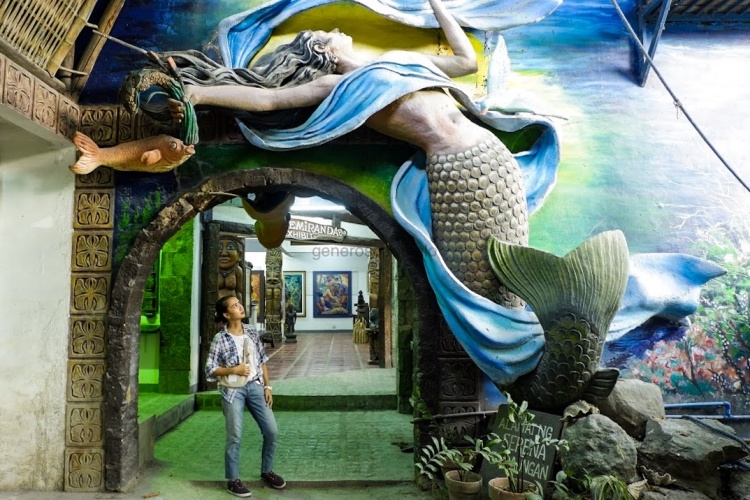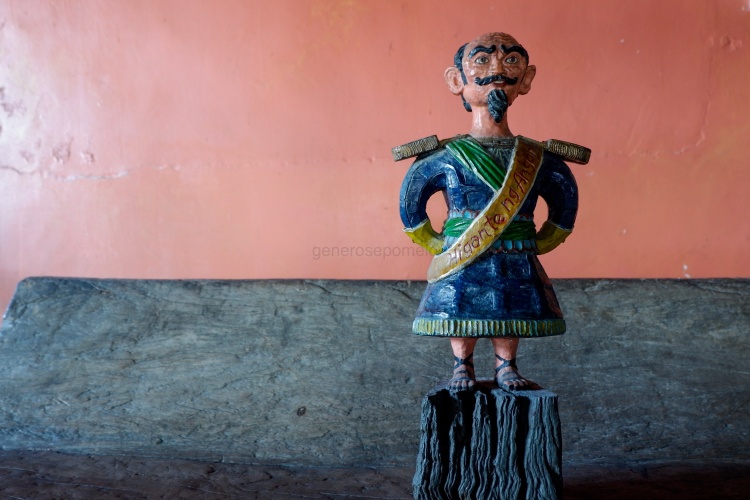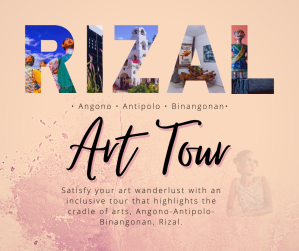A charming small town in the province of Rizal has some supernatural secrets.
It is the home town of two National Artists and cradle of many amazing artists. Thus, the art capital of the Philippines. It might have been the air, or the natural surroundings, that give these artists inspiration to create masterpieces. Or more of embracing their culture creatively and make the best of it. Perhaps, art in itself is an expression even of the unexplainable.

Oldest Art
Circa 3000 BC, early inhabitants of now town of Angono, had already illustrated their artistry by carving rocks or petroglyphs. In 1965 National Artist for Visual Arts, Carlos “Botong” Francisco, discovered these primitive carvings while on a field trip with a troop of rover scouts. These petroglyphs are located in the rear recess of a cave at the boundary of Angono and Binangonan, carved in a rock formation belonging to the Pleistocene Guadalupe Formation. There are 127 figures engraved into volcanic tuff, soft enough to be pecked on by a denser piece of stone. Archeological finds yielded four stone tools and fragments of earthenware, obsidian flakes, and shells.

Inception of Ang Nuno
Legends have it that the town’s name has supernatural origins. From a well-documented story by UP Prof. emeritus Ligaya Tiamson-Rubin, that a medicinal tree called Anono used to grow abundantly in the area to a story shared to the town’s first historian, Eugenio Lara, that there lived a Datu or Raja locally called “ang puno o pinuno,”before the Spaniards came. Another research by Prof. Ligaya, states that Ang Nuno is an old-wise-man and a folk-healer, considered the head of the town.
Carlos ”Botong” Francisco, an avid historian himself, discovered that natives shun from cutting any part of a tree called, Balete, with the belief that their ancestors live in it together with the guardian, Ang Nuno, as per the writings of a 17th century Italian voyager, Giovanni Francesco Gemelli Careri. Then, as a National Artist for Visual Arts, people believed his uncovering of the town’s uncanny name roots.

Siren Hymns
Running across town is a river system from its hills down to the lakeshore. Right in the heart of the town is the deepest part of the river with surrounding Bangkal and bamboo trees. It’s said to be at Bero’s wharf near the church. At this spot, there lived a siren with golden yellow hair, wide, and thick hands, long arms, a beautiful singing voice, and a glittering tail, that fluttered like a big fish in the moonlight. At midnight, some say they hear the sweet song of sirens, as corroborated by Prof. Ligaya Tiamson-Rubin in her book, Angono Art Capital Book 1.
Midnight hymns that may have inspired the National Artist for Music, Lucio D. San Pedro, create iconic and famous compositions. He was also a conductor and led the Banda Angono Numero Uno, Manila Symphony Orchestra, Musical Philippines Philharmonic Orchestra, Peng Kong Grand Mason Concert Band, and the San Pedro Band of Angono.

Cradle of HIGANTES
At dawn, peasants clamor in front of a figure which appears to be a tall mestizo with his arms akimbo, a stance that’s so familiar with everyone at the Hacienda. This figure is said to be of Zacarias’ the peasants’ landlord. ”Tangkad” as they refer to him, was made into an effigy, as a symbol for an agrarian protest, against the belittling Haciendero. A tale of the ”higante” passed onto natives since then and documented by Prof. Ligaya Tiamson-Rubin.
Then in the 1940s, the figure resurfaced not as a satire but as a festive symbol. When Carlos ”Botong” Francisco, created a version of the ”higante” to parade around town to defy the town’s sorrow post-WWII. And as per Angono native and FEU Prof. Owen Saguinsin, “higante” was a really a post-war icon.
Artemio Tajan, was the creator of the couple higante; then in the 70’s ”Anak ng higante,” was introduced, to be part of the ”pamilya higante.”
A decade later, Perdigon Vocalan, was the brains behind the Higantes Festival amongst the town’s barangays. In the 90s, the municipality promoted Higantes Festival as part of the ”One Town, One Product” campaign of the Department of Trade and Industry. Then eventually included in the recognized festivals of the Department of Tourism until today.
Oldest rock art on its hills, Balete tree guardian in its plains, a scaly lurker in its river and giant dwellers, Angono sure is a supernatural artsy town.



One thought on “The Supernatural Artsy Town of Angono, Rizal”